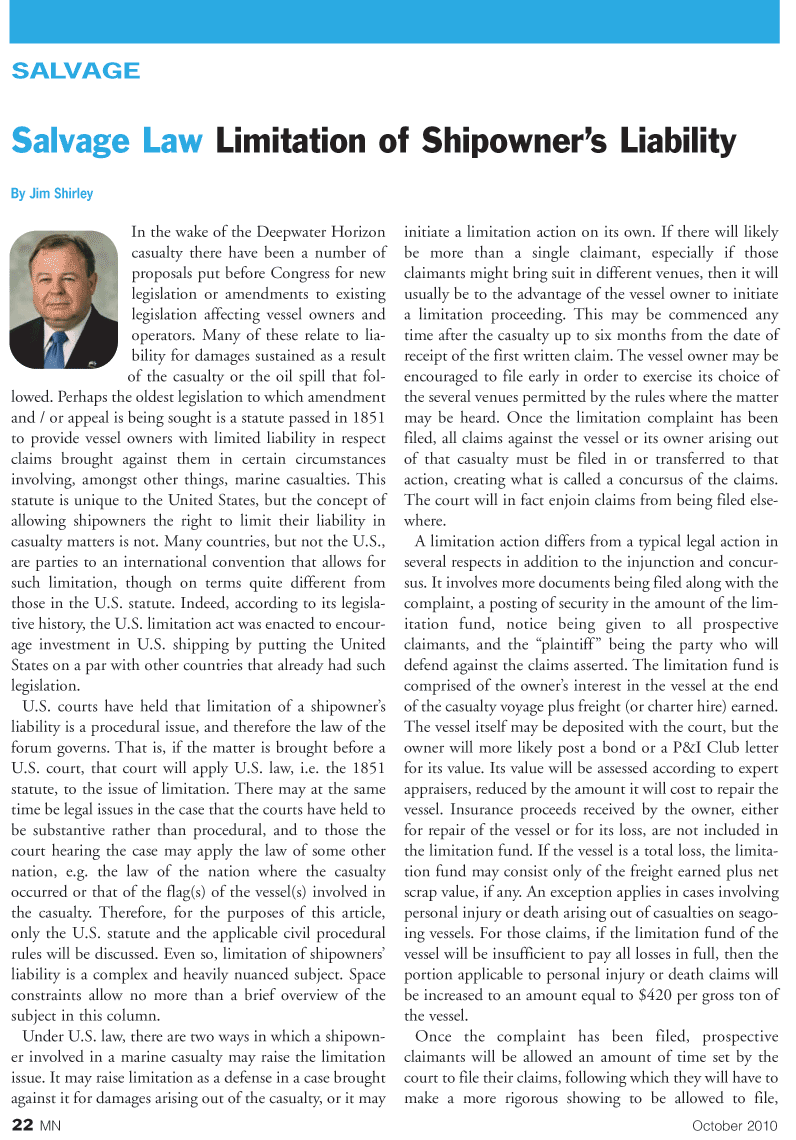
Page 22: of Marine News Magazine (October 2010)
Annual World Yearbook
Read this page in Pdf, Flash or Html5 edition of October 2010 Marine News Magazine
22 MN October 2010
SALVAGE
In the wake of the Deepwater Horizon casualty there have been a number of proposals put before Congress for new legislation or amendments to existing legislation affecting vessel owners and operators. Many of these relate to lia- bility for damages sustained as a result of the casualty or the oil spill that fol- lowed. Perhaps the oldest legislation to which amendment and / or appeal is being sought is a statute passed in 1851 to provide vessel owners with limited liability in respect claims brought against them in certain circumstances involving, amongst other things, marine casualties. This statute is unique to the United States, but the concept of allowing shipowners the right to limit their liability in casualty matters is not. Many countries, but not the U.S., are parties to an international convention that allows for such limitation, though on terms quite different from those in the U.S. statute. Indeed, according to its legisla- tive history, the U.S. limitation act was enacted to encour- age investment in U.S. shipping by putting the United
States on a par with other countries that already had such legislation.
U.S. courts have held that limitation of a shipowner’s liability is a procedural issue, and therefore the law of the forum governs. That is, if the matter is brought before a
U.S. court, that court will apply U.S. law, i.e. the 1851 statute, to the issue of limitation. There may at the same time be legal issues in the case that the courts have held to be substantive rather than procedural, and to those the court hearing the case may apply the law of some other nation, e.g. the law of the nation where the casualty occurred or that of the flag(s) of the vessel(s) involved in the casualty. Therefore, for the purposes of this article, only the U.S. statute and the applicable civil procedural rules will be discussed. Even so, limitation of shipowners’ liability is a complex and heavily nuanced subject. Space constraints allow no more than a brief overview of the subject in this column.
Under U.S. law, there are two ways in which a shipown- er involved in a marine casualty may raise the limitation issue. It may raise limitation as a defense in a case brought against it for damages arising out of the casualty, or it may initiate a limitation action on its own. If there will likely be more than a single claimant, especially if those claimants might bring suit in different venues, then it will usually be to the advantage of the vessel owner to initiate a limitation proceeding. This may be commenced any time after the casualty up to six months from the date of receipt of the first written claim. The vessel owner may be encouraged to file early in order to exercise its choice of the several venues permitted by the rules where the matter may be heard. Once the limitation complaint has been filed, all claims against the vessel or its owner arising out of that casualty must be filed in or transferred to that action, creating what is called a concursus of the claims.
The court will in fact enjoin claims from being filed else- where.
A limitation action differs from a typical legal action in several respects in addition to the injunction and concur- sus. It involves more documents being filed along with the complaint, a posting of security in the amount of the lim- itation fund, notice being given to all prospective claimants, and the “plaintiff” being the party who will defend against the claims asserted. The limitation fund is comprised of the owner’s interest in the vessel at the end of the casualty voyage plus freight (or charter hire) earned.
The vessel itself may be deposited with the court, but the owner will more likely post a bond or a P&I Club letter for its value. Its value will be assessed according to expert appraisers, reduced by the amount it will cost to repair the vessel. Insurance proceeds received by the owner, either for repair of the vessel or for its loss, are not included in the limitation fund. If the vessel is a total loss, the limita- tion fund may consist only of the freight earned plus net scrap value, if any. An exception applies in cases involving personal injury or death arising out of casualties on seago- ing vessels. For those claims, if the limitation fund of the vessel will be insufficient to pay all losses in full, then the portion applicable to personal injury or death claims will be increased to an amount equal to $420 per gross ton of the vessel.
Once the complaint has been filed, prospective claimants will be allowed an amount of time set by the court to file their claims, following which they will have to make a more rigorous showing to be allowed to file,
Salvage Law Limitation of Shipowner’s Liability
By Jim Shirley

 21
21

 23
23
